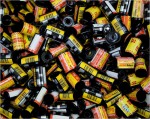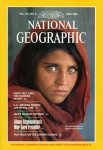 Dwayne’s Photo in Parsons, Kansas, developed the last roll of Kodachrome film on Thursday. As digital photography took over and developing outlets closed en masse, Kodak announced in June of 2009 that after 74 years of iconic success, they would no longer produce the development chemicals necessary to print Kodachrome negatives. Dwayne’s Photo got a special dispensation. Kodak ensured that as the only shop left not just in the United States but in the world, they would receive the chemicals through the end of 2010.
Dwayne’s Photo in Parsons, Kansas, developed the last roll of Kodachrome film on Thursday. As digital photography took over and developing outlets closed en masse, Kodak announced in June of 2009 that after 74 years of iconic success, they would no longer produce the development chemicals necessary to print Kodachrome negatives. Dwayne’s Photo got a special dispensation. Kodak ensured that as the only shop left not just in the United States but in the world, they would receive the chemicals through the end of 2010.
Kodachrome was the first successful mass-produced color film process. It created a rich depth of color and warm light which made it a favorite of videographers and photographers, peaking in the 1960s. Paul Simon even wrote a song about it whose lyrics include, “They give us those nice bright colours. They give us the greens of summers. Makes you think all the world’s a sunny day.”
Or not so sunny, as the case would have it. Abraham Zapruder shot his famous footage of the assassination of John F. Kennedy on Kodachrome film.
Before the deadline loomed so prominently, the store was developing an average of 700 rolls of film a day, which is a remarkable amount considering the dominance of digital. The end of an era stimulated a huge final rush of people bringing in every roll they’ve had lying around for decades.
In the last weeks, dozens of visitors and thousands of overnight packages have raced here, transforming this small prairie-bound city not far from the Oklahoma border for a brief time into a center of nostalgia for the days when photographs appeared not in the sterile frame of a computer screen or in a pack of flimsy prints from the local drugstore but in the warm glow of a projector pulling an image from a carousel of vivid slides.
In the span of minutes this week, two such visitors arrived. The first was a railroad worker who had driven from Arkansas to pick up 1,580 rolls of film that he had just paid $15,798 to develop. The second was an artist who had driven directly here after flying from London to Wichita, Kan., on her first trip to the United States to turn in three rolls of film and shoot five more before the processing deadline.
The artist, Aliceson Carter, 42, was incredulous as she watched the railroad worker, Jim DeNike, 53, loading a dozen boxes that contained nearly 50,000 slides into his old maroon Pontiac. He explained that every picture inside was of railroad trains and that he had borrowed money from his father’s retirement account to pay for developing them.
Is it weird if I hope that he’s able to digitize that collection some day?
 The last roll of film Kodak made they gave to photographer Steve McCurry, the author of the famous portrait, shot in Kodachrome, of an Afghan girl with piercing green eyes that was on the cover of National Geographic in 1985. He shot pictures in New York and India on the roll and took it to Dwayne’s Photo in person for development.
The last roll of film Kodak made they gave to photographer Steve McCurry, the author of the famous portrait, shot in Kodachrome, of an Afghan girl with piercing green eyes that was on the cover of National Geographic in 1985. He shot pictures in New York and India on the roll and took it to Dwayne’s Photo in person for development.
His wasn’t the last roll to be developed, though. That honor went to Dwayne’s owner Dwayne Steinle, but first he had to fish out a camera that actually worked, because, o tempora o mores, he himself uses a digital camera these days. He took pictures of the town in the last week of Kodachrome, leaving the last space on the roll for a group photo of all of Dwayne’s Photo’s employees standing in front of the store wearing custom printed t-shirts to mark the moment: “The best slide and movie film in history is now officially retired. Kodachrome: 1935-2010.”